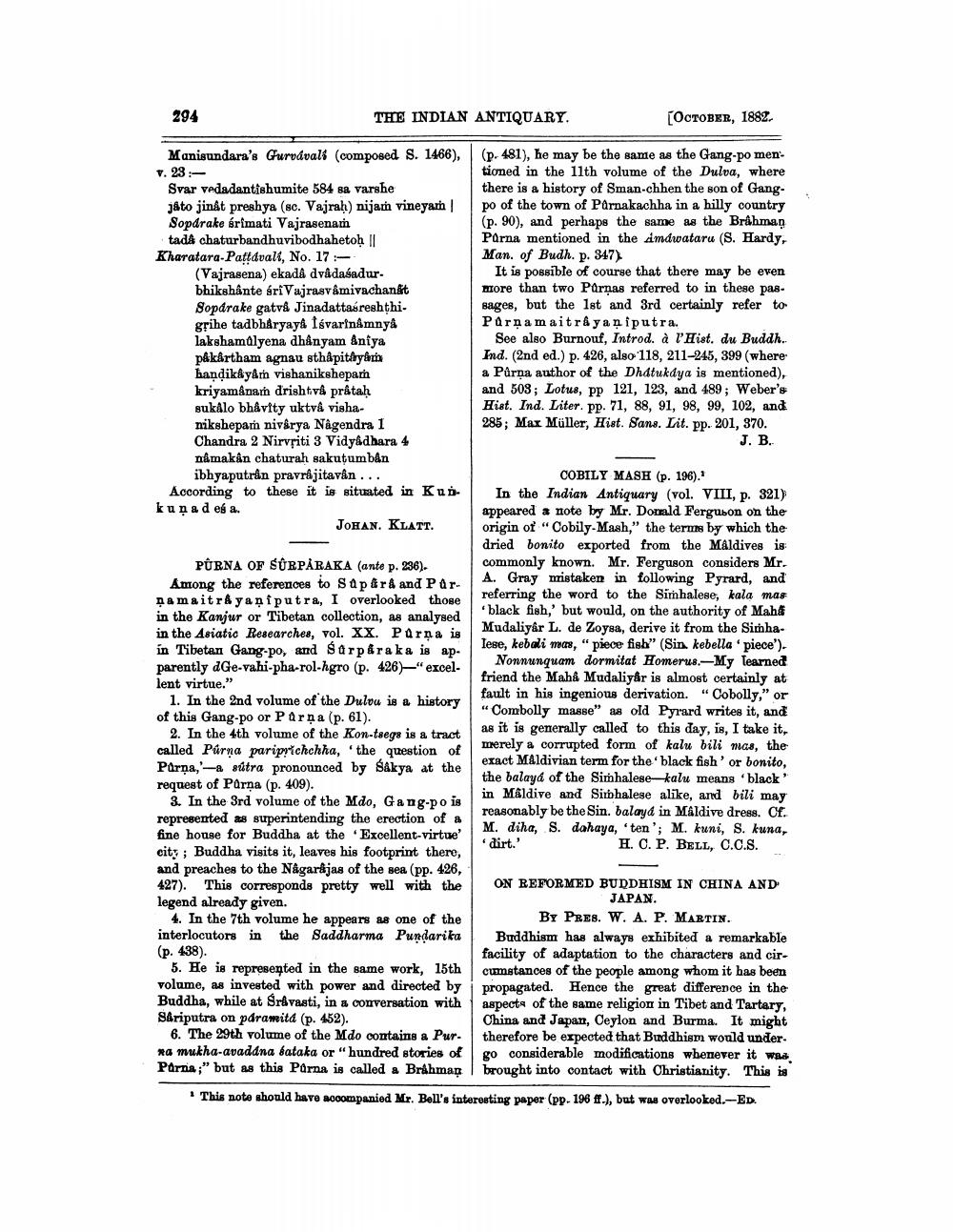________________
294
THE INDIAN ANTIQUARY.
[OCTOBER, 1882.
Manisundara's Curvával (composed S. 1466), v. 23:
Svar vedadantiehumite 584 sa varshe játo jinát preshya (sc. Vajraḥ) nijar vineyath | Sopdrake srimati Vajrasenam
tada chaturbandhuvibodhahetoh || Kharatara Pattavall, No. 17 :
(Vajrasena) ekadá dvådaśadur. bhikshậnte ári Vajrasvâmivachangt Sopdrake gatvå Jinadattasreshthi. grihe tadbharyaya fśvarinâmnya lakshamalyena dhanyam aniya påkårtham agnau sthåpitayam handik&yâm vishanikshepam kriyamanam drishtvå prataḥ sukalo bhävity uktvå vishanikshepam nivêrya Nagendra 1 Chandra 2 Nirvșiti 3 Vidyadhara 4 nimakan chaturah sakutumban
ibhyaputran pravrajitavân ... According to these it is situated in Kud kunad es a.
JOHAN. KLATT.
(p. 481), he may be the same as the Gang-po men. tioned in the 11th volume of the Dulva, where there is a history of Sman-chhen the son of Gangpo of the town of Parnakachha in a hilly country (p. 90), and perhaps the same as the Br&hman Pärna mentioned in the Amdwataru (S. Hardy, Man. of Budh. p. 847)
It is possible of course that there may be even more than two Parnas referred to in these pas. sages, but the 1st and 3rd certainly refer to Parnamaitrå yaniputra.
See also Burnouf, Introd. à 'Hist. du Buddh. Ind. (2nd ed.) p. 426, also 118, 211-245, 399 (where a Pärna author of the Dhatukdya is mentioned), and 503; Lotus, pp 121, 123, and 489; Weber's Hist. Ind. Liter. pp. 71, 88, 91, 98, 99, 102, and 285; Mar Müller, Hist. Sans. Lit. pp. 201, 370.
J. B.
PÛRNA OF SURPÅRAKA (ante p. 236). Among the references to Sap &r & and Par. na maitrAyaniputra, I overlooked those in the Kanjur or Tibetan collection, as analysed in the Asiatic Researches, vol. XX. Parna is in Tibetan Gang-po, and strpkraka is apparently Ge-vahi-pha-rol-hgro (p. 426)—"excellent virtue."
1. In the 2nd volume of the Dulou is a history of this Gang-po or Parņa (p. 61).
2. In the 4th volume of the Kon-tsega is a tract called Púrna pariprichchha, 'the question of Parna,' sútra pronounced by Śakya at the request of Parņa (p. 409).
3. In the 3rd volume of the Mdo, Gang-po is represented as superintending the erection of a fine house for Buddha at the Excellent-virtue' city; Buddha visits it, leaves his footprint there, and preaches to the Nagarajas of the sea (pp. 426, 427). This corresponds pretty well with the legend already given.
4. In the 7th volume he appears as one of the interlocutors in the Saddharma Pundarika (p. 438).
5. He is represented in the same work, 15th volume, as invested with power and directed by Buddha, while at Sravasti, in a conversation with Sariputra on pdraweitd (p. 452).
6. The 29th volume of the Mdo contains a Pur. na mukha-avaddna bataka or "hundred stories of Parna;" but as this Parna is called a Brahman
COBILY MASH (p. 196)." In the Indian Antiquary (vol. VIII, p. 321) appeared a note by Mr. Donald Ferguson on the origin of "Cobily. Mash," the terms by which the dried bonito exported from the Maldives is commonly known. Mr. Ferguson considers Mr. A. Gray mistaken in following Pyrard, and referring the word to the Sinhalese, kala mas
black fish,' but would, on the authority of Mah& Mudaliyâr L. de Zoysa, derive it from the Simhalese, kebali was, "piece fish" (Sin. kebella" piece').
Nonnunquam dormitat Homerus.-My Tearned friend the Maha Mudaliyar is almost certainly at fault in his ingenious derivation. "Cobolly," or "Combolly masse" as old Pyrard writes it, and as it is generally called to this day, is, I take it, merely a corrupted form of kalu bili mas, the exact Maldivian term for the black fish'or bonito, the balaya of the Sinhalese-kalu means 'black' in Maldive and Sibhalese alike, and bili may reasonably be the Sin. balayd in Maldive dress. Cf. M. diha, S. dahaya, 'ten'; M. kuni, S. kuna, dirt.'
H.O.P. BELL, C.C.S.
ON REFORMED BUDDHISM IN CHINA AND
JAPAN. By Pres. W. A. P. MARTIN. Buddhism has always exhibited a remarkable facility of adaptation to the characters and cir. cumstances of the people among whom it has been propagated. Hence the great difference in the aspects of the same religion in Tibet and Tartary, China and Japan, Ceylon and Burma. It might therefore be expected that Buddhism would under. go considerable modifications whenever it was brought into contact with Christianity. This is
This noto should have accompanied Mr. Bell's interesting paper (pp. 196 fr.), but was overlooked.-ED.




